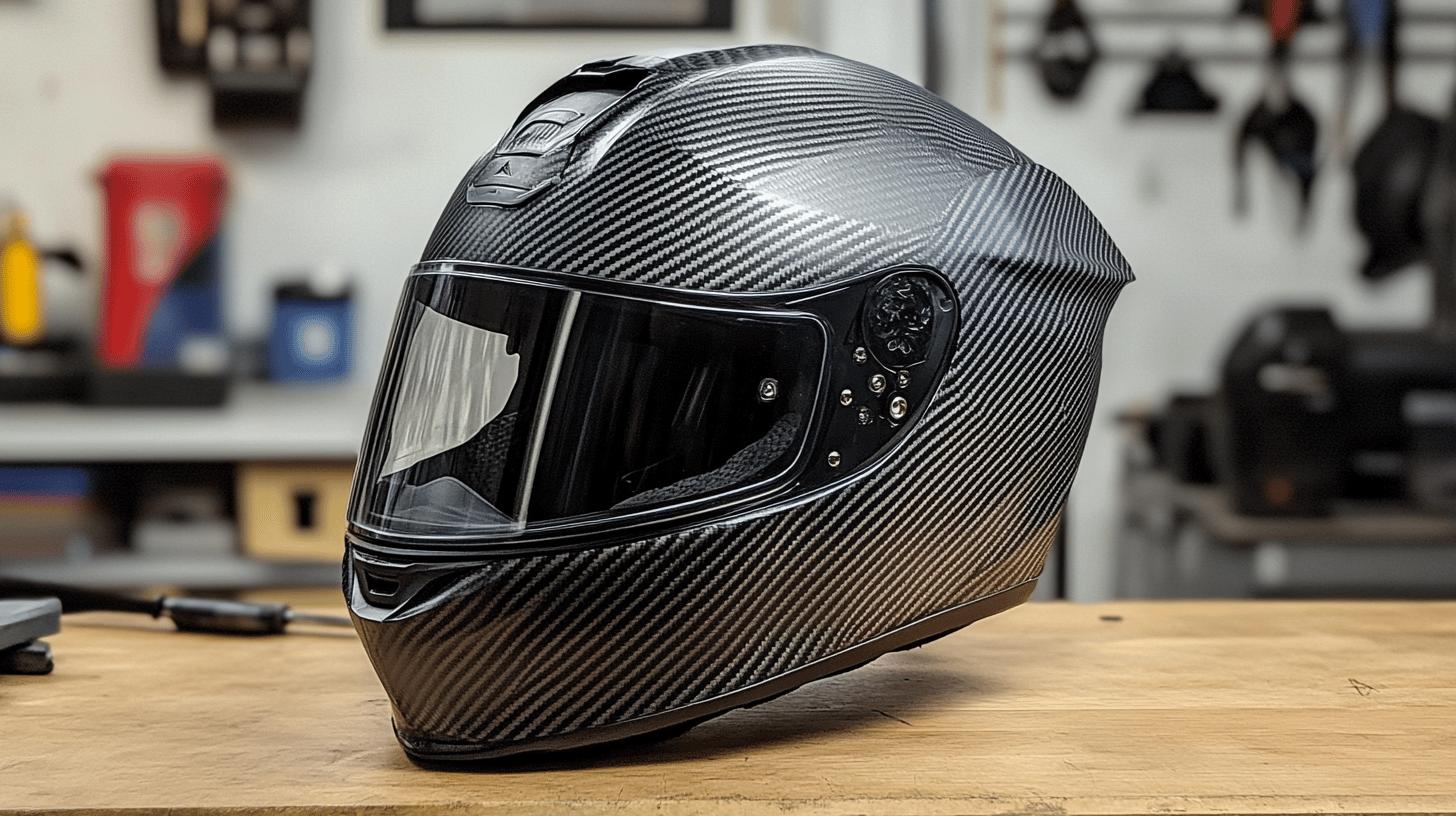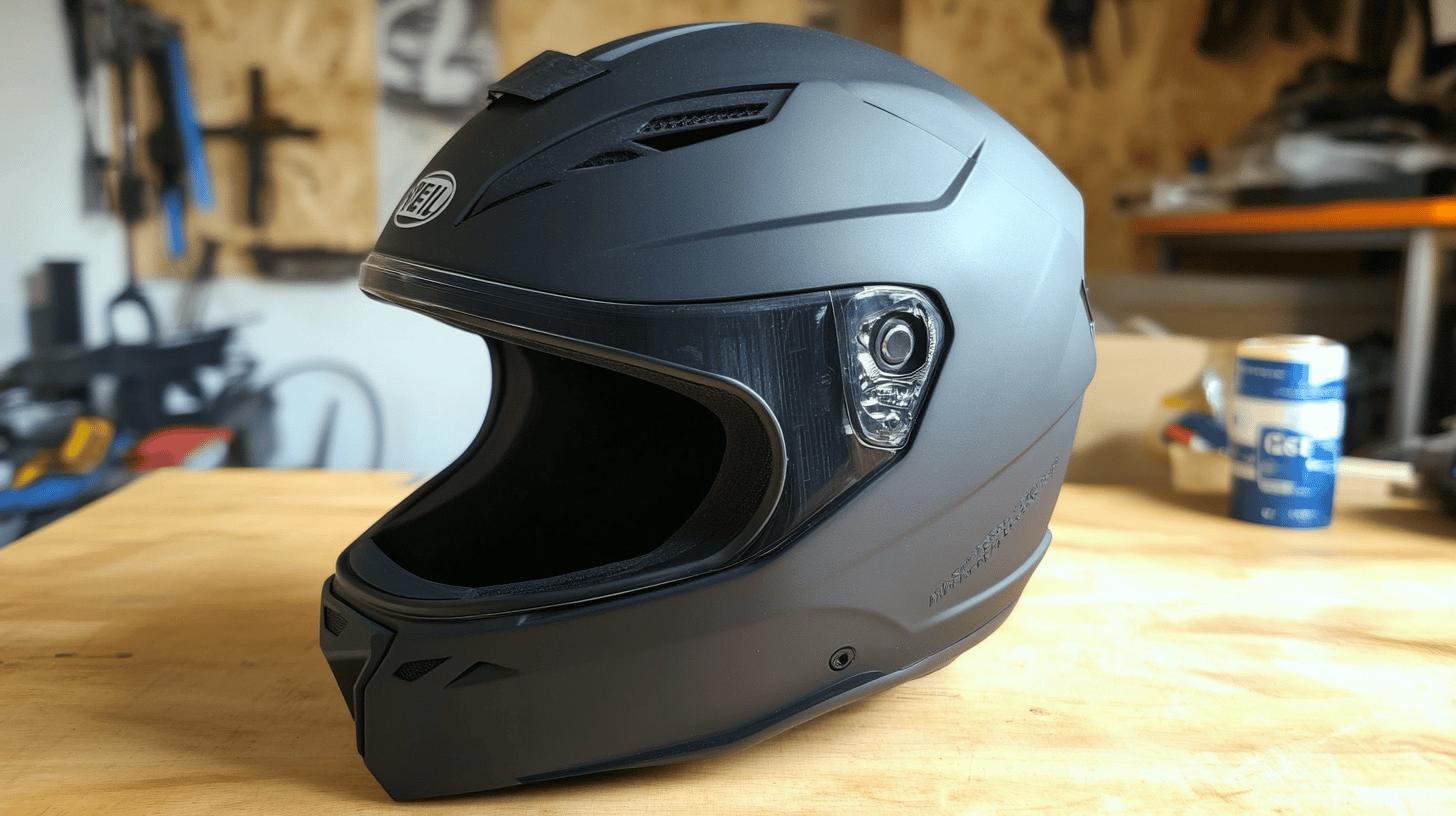What makes a motorcycle helmet more than just a stylish accessory? The answer lies beneath its surface—the carefully selected materials that form its core.
Motorcycle helmets are more than just a hard shell; they are sophisticated safety devices engineered from an array of materials like polycarbonate, fiberglass, and carbon fiber. Each is chosen for its unique properties that contribute to impact resistance, weight balance, and durability.
In this guide, we'll dissect what makes each material crucial, how they work harmoniously, and why understanding them enhances your riding experience. Prepare to explore the science protecting your most valuable asset—your head.
Understanding the Core Materials in Motorcycle Helmets

Motorcycle helmets rely heavily on the materials used in their construction to provide safety and durability. Each material is selected for its unique properties, which contribute to the helmet's overall performance in protecting the rider. The choice of materials can affect the helmet's weight, strength, and ability to absorb impact.
-
Polycarbonate: Known for its affordability and impact resistance, making it a popular choice.
-
Fiberglass: Offers a balance of strength and weight, often used in mid-range helmets.
-
Carbon Fiber: Provides superior strength with minimal weight, often found in high-end helmets.
- Expanded Polystyrene (EPS): Commonly used for impact-absorbing liners, crucial for energy dissipation.
Polycarbonate is a thermoplastic material widely favored for its capacity to absorb impacts effectively while maintaining affordability. Its ability to deform upon impact helps in dispersing energy, reducing the force transmitted to the rider's head. This makes polycarbonate helmets a cost-effective option for many riders who prioritize safety without breaking the bank.
Fiberglass is another core material, appreciated for its excellent strength-to-weight ratio. It combines multiple layers of woven glass fibers with a resin, creating a shell that is both strong and lightweight. This material provides a good balance, making fiberglass helmets comfortable for long rides while offering robust protection. The flexibility of fiberglass also allows for better customization in terms of design and fit.
Carbon fiber, known for its cutting-edge properties, is often used in premium helmets due to its remarkable strength and lightweight characteristics. The material's architecture involves tightly woven carbon strands, providing unparalleled rigidity and minimal weight. This results in helmets that not only offer top-tier protection but also reduce neck strain during prolonged use. Although generally more expensive, the investment in carbon fiber helmets pays off with enhanced durability and performance.
Exploring the Outer Shell Materials

The outer shell of a motorcycle helmet plays a crucial role in protecting the rider by deflecting impacts and distributing force across a larger area. It serves as the first line of defense, safeguarding the rider's head from direct collisions. Various materials are utilized in constructing this shell, each offering distinct benefits and drawbacks.
Polycarbonate
Polycarbonate is a thermoplastic known for its impressive impact resistance and affordability. This material's ability to absorb and disperse energy upon impact makes it a popular choice in helmet construction.
The properties of polycarbonate include its capacity to deform under pressure, which helps in minimizing the force transmitted to the rider's head. This flexibility, coupled with its cost-effectiveness, makes it an accessible option for many riders.
-
Durable and impact-resistant
-
Affordable, making it budget-friendly
-
Heavier than composite materials
- May not offer the same level of customization in design
Fiberglass
Fiberglass is a composite material that combines woven glass fibers with resin, resulting in a lightweight yet strong shell. It provides a well-balanced option for riders seeking both comfort and safety.
The strength-to-weight ratio of fiberglass allows for a lighter helmet without compromising on protection. This makes fiberglass helmets particularly appealing for long-distance riders who prioritize comfort.
-
Offers a good balance of strength and weight
-
Allows for better design customization
-
Generally more expensive than polycarbonate
- Can be more susceptible to chipping or cracking
Carbon Fiber
Carbon fiber represents the pinnacle of helmet shell materials, renowned for its superior strength and minimal weight. The structure of carbon fiber involves tightly interwoven strands, creating a rigid yet lightweight shell.
The exceptional properties of carbon fiber make it the choice for high-end helmets, offering the best protection with the least amount of weight. This reduces neck strain and enhances rider comfort, especially during prolonged use.
-
Extremely lightweight, reducing neck fatigue
-
Superior strength and impact resistance
-
Higher cost, reflecting its premium status
- Limited design flexibility due to the material's rigidity
The Role of Impact-Absorbing Liners

Impact absorption is a critical function of motorcycle helmets, designed to protect riders from the severe consequences of crashes. At the heart of this feature is the impact-absorbing liner, typically made from expanded polystyrene (EPS). This material is engineered to absorb and dissipate energy during impacts, effectively reducing the force transferred to the rider's head.
EPS liners act as a buffer, compressing under pressure to manage energy distribution, which is crucial for minimizing the risk of head injuries. The liner's ability to absorb energy significantly enhances the helmet's protective capabilities, making it a vital component in helmet construction.
-
Lightweight, adding minimal weight to the helmet
-
Excellent energy absorption properties
-
Compresses upon impact, reducing force transmission
-
Cost-effective, keeping helmets affordable
-
Contributes to the helmet's overall durability
The incorporation of EPS liners is integral to meeting and exceeding helmet safety standards. These liners are meticulously tested to ensure they perform effectively under various impact scenarios. Compliance with certifications such as DOT, ECE, and SNELL often hinges on the liner's performance, underscoring its importance in the overall safety design.
By efficiently absorbing impact energy, EPS liners not only protect the rider's head but also enhance the helmet's ability to pass rigorous safety evaluations, ensuring it provides reliable protection on the road.
Comfort Liner Materials and Features

Comfort liners in motorcycle helmets are designed to provide a snug fit and cushioning, enhancing the overall comfort for the rider. These liners play a crucial role in ensuring the helmet feels comfortable against the skin, reducing irritation during long rides and helping maintain the proper fit of the helmet.
The materials used in comfort liners typically include soft foam and moisture-wicking fabrics. Foam provides the necessary cushioning and helps in contouring the liner to fit the rider's head shape, offering personalized comfort.
Moisture-wicking fabrics are essential for managing sweat and keeping the rider's head dry, especially during warm weather or extended rides. These materials combine to create a liner that not only enhances comfort but also contributes to the helmet's fit and stability, allowing riders to focus on the road without discomfort or distraction.
Comparing Helmet Material Performance

Evaluating the performance of motorcycle helmet materials is crucial for understanding how they affect safety and rider comfort. Different materials offer varying levels of strength, weight, and cost, each impacting the helmet's effectiveness and user experience.
| Material | Strength | Weight | Cost |
|---|---|---|---|
| Polycarbonate | Moderate | Heavier | Low |
| Fiberglass | High | Moderate | Medium |
| Carbon Fiber | Very High | Lightest | High |
| Composite | High | Light | Medium |
Polycarbonate helmets are known for their moderate strength and affordability, making them a common choice for cost-conscious riders. However, their heavier weight compared to other materials can lead to increased neck fatigue during long rides.
Despite this, polycarbonate remains popular due to its balance of impact resistance and budget-friendly pricing. Riders seeking a basic yet reliable helmet often turn to polycarbonate for its practicality.
Fiberglass helmets offer higher strength and a better weight-to-strength ratio, providing a more comfortable experience for long-distance riders. The moderate weight of fiberglass can ease neck strain, while its robust construction enhances safety.
This makes fiberglass a preferred option for those prioritizing a blend of comfort and protection without reaching the premium price of carbon fiber. Its slightly higher cost reflects the balance of safety features and design flexibility, making it a versatile choice for many.
Carbon fiber helmets, while the most expensive, deliver unmatched strength and the lightest weight, significantly reducing neck fatigue. Their superior durability and lightweight nature make them ideal for riders seeking top-tier protection and comfort.
The high cost is justified by the advanced materials and cutting-edge construction techniques that provide the best in impact resistance and user comfort. For those willing to invest in ultimate performance, carbon fiber helmets stand out as the premier choice, offering long-term benefits in safety and ride quality.
Safety Standards and Certifications for Helmet Materials

Safety standards play a pivotal role in the production of motorcycle helmets, ensuring that they meet rigorous criteria for protecting riders. These standards are established to evaluate the helmet's performance in various scenarios, providing a benchmark for manufacturers to achieve. Compliance with these standards signifies that a helmet can effectively mitigate the risks associated with riding.
Key certifications, such as DOT, ECE, and SNELL, are crucial in assessing helmet safety. The DOT (Department of Transportation) certification is a mandatory standard in the United States, focusing on impact resistance and the helmet’s ability to remain intact during a crash.
ECE (Economic Commission for Europe) standards, prevalent in over 50 countries, involve a more comprehensive testing protocol, including assessments for penetration and retention. SNELL, an independent organization, conducts even more rigorous testing, evaluating impact energy management and shell deformation.
These certifications ensure that helmets provide optimal protection by testing their capability to withstand impacts, resist penetration, and maintain structural integrity under stress.
These safety standards significantly influence the choice of materials and the design of helmets. Manufacturers must select materials that not only comply with these standards but also enhance the helmet’s performance in real-world conditions.
For example, materials like carbon fiber and fiberglass are often favored for their superior strength and lightweight properties, which help achieve the desired safety benchmarks. Furthermore, the design process involves meticulous testing and refinement to ensure the helmet structure meets the stringent requirements set by these certifications, ultimately enhancing the safety and reliability of the final product.
Innovations in Helmet Material Technology

Recent advances in helmet material technology have significantly enhanced both safety and comfort for riders. Developments such as advanced thermoset resins and novel composites are at the forefront of these innovations.
Thermoset resins, known for their ability to withstand high impact forces, now integrate with lightweight composites to create helmets that offer exceptional protection without compromising on weight. These materials are engineered to absorb impact energy more efficiently, reducing the force transmitted to the rider’s head.
Additionally, new fabrication techniques allow for more aerodynamic designs, improving airflow and reducing noise levels during rides. Such innovations not only improve the helmet's protective capabilities but also enhance the overall riding experience by focusing on comfort and performance.
-
Advanced thermoset resins improve impact resistance, enhancing safety.
-
Lightweight composites reduce helmet weight, minimizing neck fatigue for riders.
-
New fabrication techniques enable more aerodynamic helmet designs.
- Enhanced materials offer better noise reduction, improving rider comfort.
These cutting-edge materials are shaping the future of helmet safety and design by pushing the boundaries of traditional helmet construction. As manufacturers continue to incorporate these innovations, helmets are becoming more tailored to the needs of modern riders, focusing on optimizing both safety and comfort.
This ongoing evolution ensures that future helmets will not only meet but exceed current safety standards, providing riders with unprecedented levels of protection and comfort on the road.
Choosing the Best Helmet Material for Your Needs

Selecting the best helmet material involves evaluating several key factors, including weight, safety, cost, and fit. These elements are crucial because they directly impact the helmet's performance and the rider's experience. A helmet's material determines its durability and protection level, while fit and comfort are essential for ensuring safety during rides.
When considering helmet materials, weight is a significant factor. Lightweight materials like carbon fiber can reduce neck fatigue, making them ideal for long rides. Safety standards such as DOT, ECE, and SNELL certifications are vital, as they ensure the helmet provides adequate protection.
Cost is another consideration; while polycarbonate helmets are more affordable, carbon fiber options, though pricier, offer enhanced strength and lighter weight. Balancing these factors helps riders select a helmet that meets their safety needs without straining their budget.
To ensure proper fit and comfort, trying on helmets before purchasing is essential. A well-fitting helmet should sit snugly on the head without causing pressure points. Look for features like adjustable straps and removable cheek pads to customize the fit.
Comfort liners made from moisture-wicking materials can enhance comfort during long rides, keeping the rider dry and focused. Prioritizing fit and comfort ensures that the helmet not only protects but also provides a pleasant riding experience.
Final Words
Diving into the world of motorcycle helmets reveals a rich tapestry of materials and innovations. From polycarbonate to carbon fiber, each offers unique benefits influencing safety, weight, and comfort. Understanding what motorcycle helmets are made of helps riders make informed choices.
With advanced technologies continually reshaping the landscape, selecting the right helmet becomes both a science and an art. Riding becomes safer and more enjoyable with the perfect helmet tailored to one's needs. Stay safe and enjoy the ride!
FAQ
What materials are motorcycle helmets made from?
Motorcycle helmets are primarily made from materials such as polycarbonate, fiberglass, carbon fiber, and expanded polystyrene (EPS). Each offers specific benefits like impact resistance and durability.
Are biker helmets bulletproof?
Biker helmets are not designed to be bulletproof. They are intended to protect against impacts in motorcycle accidents, which involve different forces and materials compared to bullet-resistant gear.
What is the best material for a motorcycle helmet?
The best material for a motorcycle helmet depends on the rider's needs. Carbon fiber is known for being lightweight and strong, fiberglass balances strength and cost, and polycarbonate is affordable and impact-resistant.
What materials are motorcycle helmet visors made of?
Motorcycle helmet visors are typically made of polycarbonate. This material is chosen for its clarity, impact resistance, and UV protection capabilities.
What are the properties of helmet materials like carbon fiber, Kevlar, and polycarbonate?
Carbon fiber offers high strength-to-weight ratio, Kevlar provides excellent tensile strength, and polycarbonate is noted for affordability and good impact resistance.
What are military helmets made of?
Military helmets are often made from advanced materials like Kevlar or aramid fibers, providing high protection against ballistic threats and impacts.

Brad Mitchell is a seasoned motorcycle enthusiast with over 16 years of riding experience. He’s spent countless hours on the open road, particularly favoring scenic routes aboard his trusted Harley-Davidson. Brad’s laid-back approach to life and riding gives him a unique perspective on motorcycle gear and safety, which he shares through his in-depth reviews and expert advice on ProtectiveGearz.



